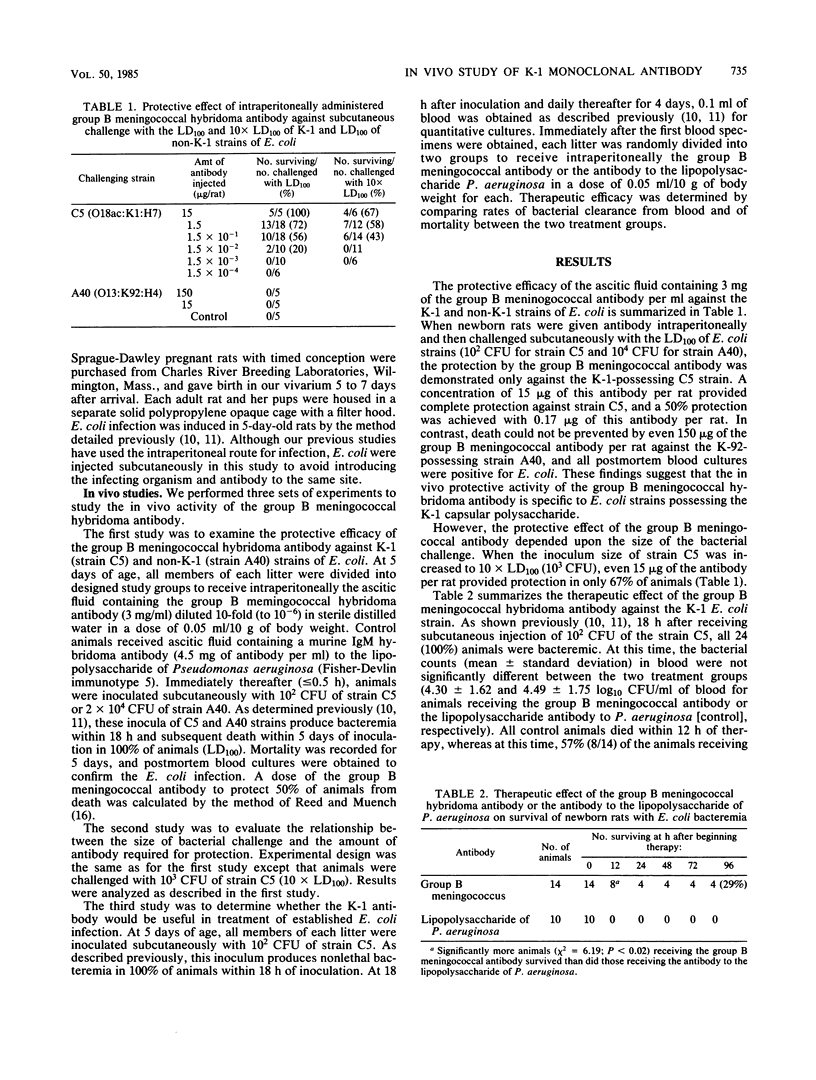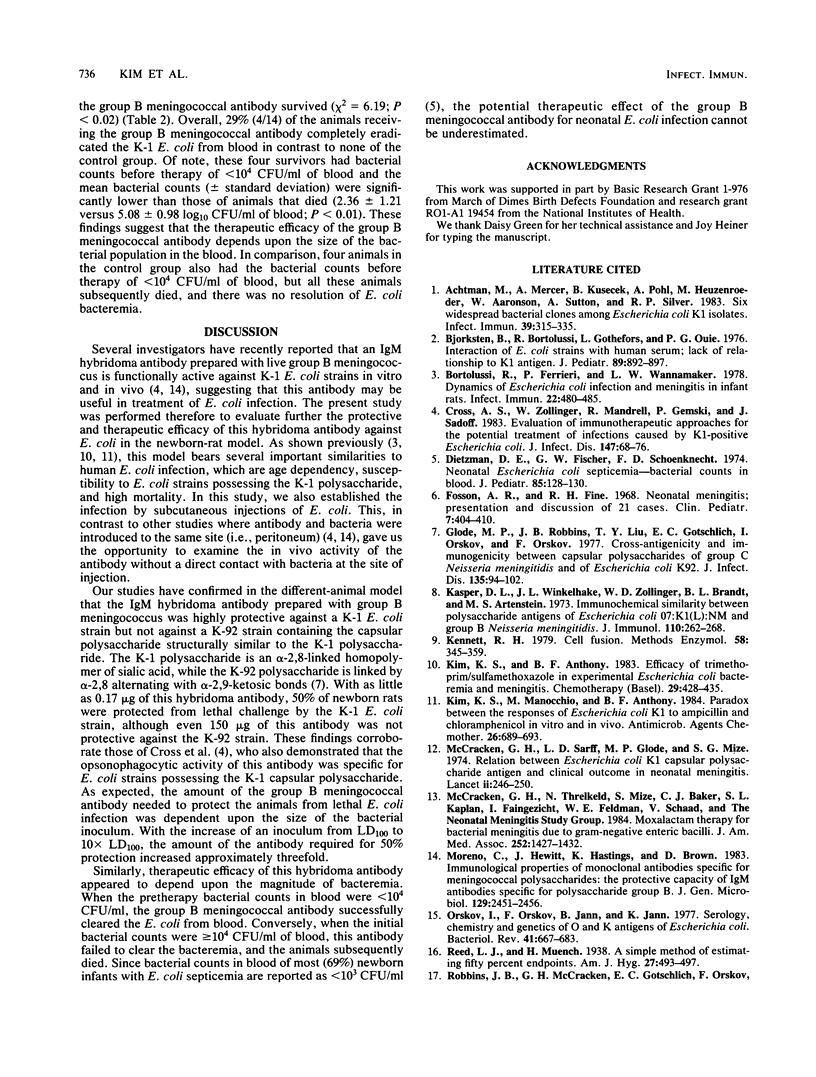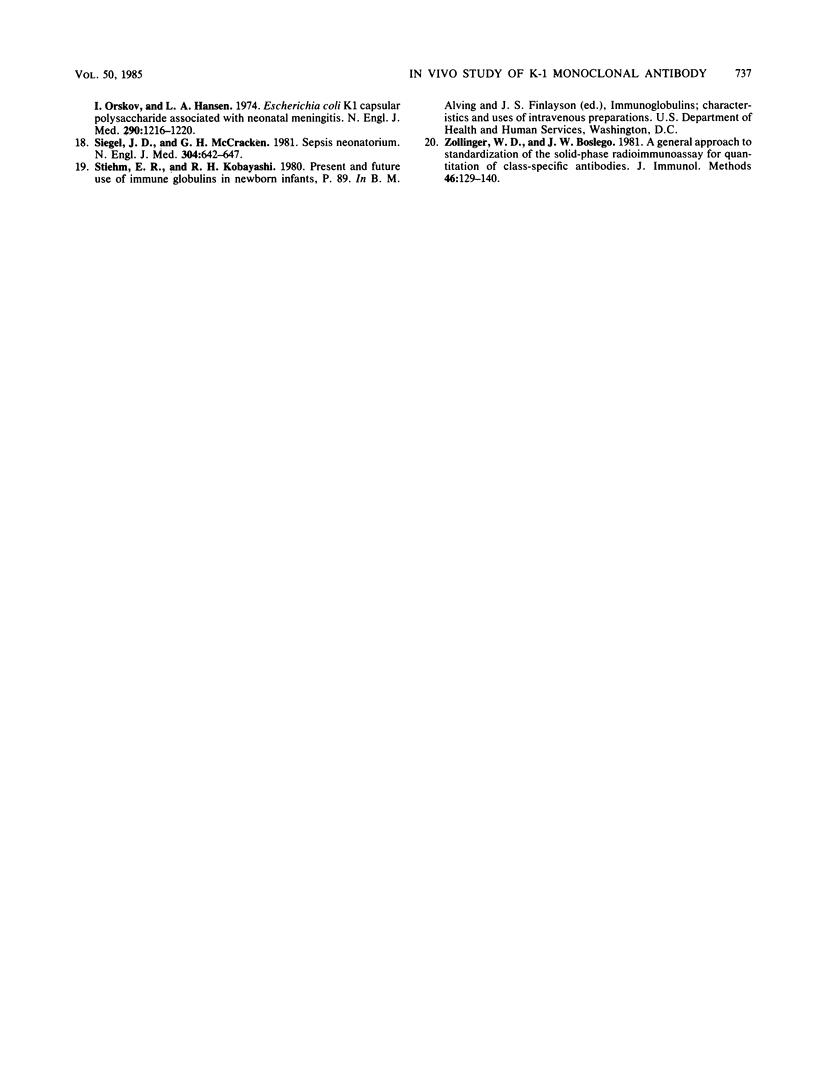Abstract
Mouse hybridoma antibody of immunoglobulin class M prepared with live group B meningococci was evaluated for its ability to protect against and treat Escherichia coli infections in a newborn-rat model. In these studies, antibody was administered intraperitoneally and bacteria were administered subcutaneously to avoid introducing the antibody and bacteria to the same site. The activity of this hybridoma antibody was specific; the antibody provided protection against the K-1 strain, but not against the K-92 strain. In addition, the amount of the antibody required for protection was dependent upon the size of bacterial challenge. With an increase of the bacterial inocula from the 100% lethal dose to 10 times the 100% lethal dose there was a threefold increase in the amount of the antibody required for 50% protection. Similarly, therapeutic efficacy of the antibody was also dependent upon the magnitude of bacteremia before therapy. The antibody successfully cleared the bacteremia only when the pretherapy bacterial counts in blood were less than 10(4) CFU/ml. These findings suggest that the monoclonal immunoglobulin M antibody against the capsular polysaccharide of the group B meningococcus may be useful in the prevention and treatment of K-1 E. coli infections.
Full text
PDF



Selected References
These references are in PubMed. This may not be the complete list of references from this article.
- Achtman M., Mercer A., Kusecek B., Pohl A., Heuzenroeder M., Aaronson W., Sutton A., Silver R. P. Six widespread bacterial clones among Escherichia coli K1 isolates. Infect Immun. 1983 Jan;39(1):315–335. doi: 10.1128/iai.39.1.315-335.1983. [DOI] [PMC free article] [PubMed] [Google Scholar]
- Björkstén B., Bortolussi R., Gothefors L., Quie P. G. Interaction of E. coli strains with human serum: lack of relationship to K1 antigen. J Pediatr. 1976 Dec;89(6):892–897. doi: 10.1016/s0022-3476(76)80592-6. [DOI] [PubMed] [Google Scholar]
- Bortolussi R., Ferrieri P., Wannamaker L. W. Dynamics of Escherichia coli infection and meningitis in infant rats. Infect Immun. 1978 Nov;22(2):480–485. doi: 10.1128/iai.22.2.480-485.1978. [DOI] [PMC free article] [PubMed] [Google Scholar]
- Cross A. S., Zollinger W., Mandrell R., Gemski P., Sadoff J. Evaluation of immunotherapeutic approaches for the potential treatment of infections caused by K1-positive Escherichia coli. J Infect Dis. 1983 Jan;147(1):68–76. doi: 10.1093/infdis/147.1.68. [DOI] [PubMed] [Google Scholar]
- Dietzman D. E., Fischer G. W., Schoenknecht F. D. Neonatal Escherichia coli septicemia--bacterial counts in blood. J Pediatr. 1974 Jul;85(1):128–130. doi: 10.1016/s0022-3476(74)80308-2. [DOI] [PubMed] [Google Scholar]
- Fosson A. R., Fine R. N. Neonatal meningitis. Presentation and discussion of 21 cases. Clin Pediatr (Phila) 1968 Jul;7(7):404–410. doi: 10.1177/000992286800700712. [DOI] [PubMed] [Google Scholar]
- Glode M. P., Robbins J. B., Liu T. Y., Gotschlich E. C., Orskov I., Orskov F. Cross-antigenicity and immunogenicity between capsular polysaccharides of group C Neisseria meningitidis and of Escherichia coli K92. J Infect Dis. 1977 Jan;135(1):94–104. doi: 10.1093/infdis/135.1.94. [DOI] [PubMed] [Google Scholar]
- Kasper D. L., Winkelhake J. L., Zollinger W. D., Brandt B. L., Artenstein M. S. Immunochemical similarity between polysaccharide antigens of Escherichia coli 07: K1(L):NM and group B Neisseria meningitidis. J Immunol. 1973 Jan;110(1):262–268. [PubMed] [Google Scholar]
- Kennett R. H. Cell fusion. Methods Enzymol. 1979;58:345–359. doi: 10.1016/s0076-6879(79)58149-x. [DOI] [PubMed] [Google Scholar]
- Kim K. S., Anthony B. F. Efficacy of trimethoprim/sulfamethoxazole in experimental Escherichia coli bacteremia and meningitis. Chemotherapy. 1983;29(6):428–435. doi: 10.1159/000238231. [DOI] [PubMed] [Google Scholar]
- Kim K. S., Manocchio M., Anthony B. F. Paradox between the responses of Escherichia coli K1 to ampicillin and chloramphenicol in vitro and in vivo. Antimicrob Agents Chemother. 1984 Nov;26(5):689–693. doi: 10.1128/aac.26.5.689. [DOI] [PMC free article] [PubMed] [Google Scholar]
- McCracken G. H., Jr, Sarff L. D., Glode M. P., Mize S. G., Schiffer M. S., Robbins J. B., Gotschlich E. C., Orskov I., Orskov F. Relation between Escherichia coli K1 capsular polysaccharide antigen and clinical outcome in neonatal meningitis. Lancet. 1974 Aug 3;2(7875):246–250. doi: 10.1016/s0140-6736(74)91413-5. [DOI] [PubMed] [Google Scholar]
- McCracken G. H., Jr, Threlkeld N., Mize S., Baker C. J., Kaplan S. L., Faingezicht I., Feldman W. E., Schaad U. Moxalactam therapy for neonatal meningitis due to gram-negative enteric bacilli. A prospective controlled evaluation. JAMA. 1984 Sep 21;252(11):1427–1432. [PubMed] [Google Scholar]
- Moreno C., Hewitt J., Hastings K., Brown D. Immunological properties of monoclonal antibodies specific for meningococcal polysaccharides: the protective capacity of IgM antibodies specific for polysaccharide group B. J Gen Microbiol. 1983 Aug;129(8):2451–2456. doi: 10.1099/00221287-129-8-2451. [DOI] [PubMed] [Google Scholar]
- Orskov I., Orskov F., Jann B., Jann K. Serology, chemistry, and genetics of O and K antigens of Escherichia coli. Bacteriol Rev. 1977 Sep;41(3):667–710. doi: 10.1128/br.41.3.667-710.1977. [DOI] [PMC free article] [PubMed] [Google Scholar]
- Robbins J. B., McCracken G. H., Jr, Gotschlich E. C., Orskov F., Orskov I., Hanson L. A. Escherichia coli K1 capsular polysaccharide associated with neonatal meningitis. N Engl J Med. 1974 May 30;290(22):1216–1220. doi: 10.1056/NEJM197405302902202. [DOI] [PubMed] [Google Scholar]
- Siegel J. D., McCracken G. H., Jr Sepsis neonatorum. N Engl J Med. 1981 Mar 12;304(11):642–647. doi: 10.1056/NEJM198103123041105. [DOI] [PubMed] [Google Scholar]
- Zollinger W. D., Boslego J. W. A general approach to standardization of the solid-phase radioimmunoassay for quantitation of class-specific antibodies. J Immunol Methods. 1981;46(2):129–140. doi: 10.1016/0022-1759(81)90130-7. [DOI] [PubMed] [Google Scholar]


